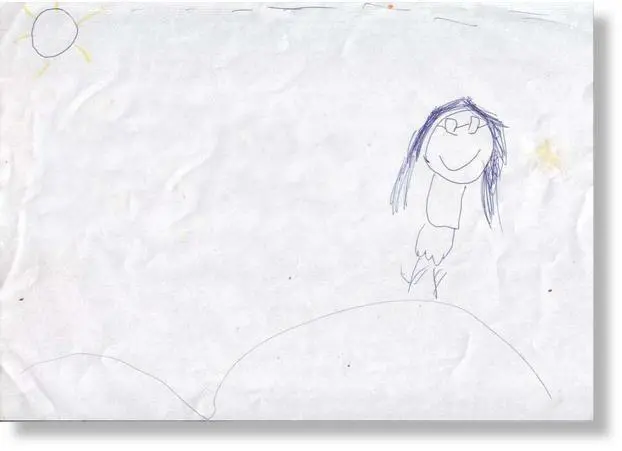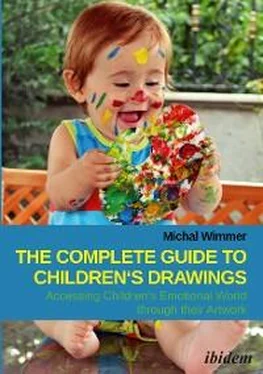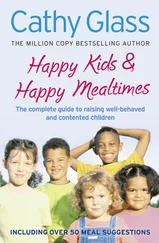Family Coalitions
One of the keys to analyzing family drawings is identifying the common denominator to all family members. In children’s drawings this could mean similar colors, drawing style, clothing, accessories and so on. Children draw family members close to each other, even if they are distant in reality. By identifying the common denominator in a family, you will also be able to reach conclusions regarding inner family coalitions that are significant to the entire family dynamic.
Internal family coalitions refer to both overt and covert coalitions between parents and children that form the family power structure. For example, if children, during an argument, often tend to agree with the mother, it will be very hard for the father to stand up to all of them.
Nevertheless, it is important to note that the way a child draws his family does not necessarily reflect the reality he lives in. Children often beautify their lived reality or draw more desirable family power balances. Be that as it may, drawings will enable you to understand how family relationships are perceived by a child and reach conclusions regarding his general behavior.
Most approaches to analyzing family drawings rely on Salvador Minuchin’s structural family therapy (1974). Structural family therapy basically assumes that the family is a structure in which a person’s identity is shaped.
According to this theory, the family is a living and developing organism. Similarly, the inner dynamics of family drawings also change as the family evolves. Eventually, the goal of drawing analysis is to find family-relevant solutions rather or in addition to particular solutions tailored to each member.
In spontaneous drawings, based on the ambiguous instruction “draw a family”, you can clearly see whether a child is aware of his family boundaries. Drawings reveal how a child perceives the subsystems in his family. In other words, drawings will show his attitude towards parents and siblings. Some of the most common ways children use to describe relationships in a family are distance between figures, height and width of family figures, different colors and clothing.

Figure 3-1:Family coalition
At first glance, the drawing in figure 3-1 does not seem to indicate the existence of any internal family coalition, mainly because all family members are drawn in the same color and all seem to be of the same height. However, the topographical location of the figures on the page (the form of the ground line beneath their legs) indicates the existence of a coalition nevertheless, with the eldest boy standing on the same plain together with his parents, while the 5½ year-old girl who made this drawing and her little brother forced onto a different plain, with added “grass” to compensate for their stature and make them as “tall” as the eldest brother and the parents. In this case, height of course represents dominance in the family system.
The behavioral approach and its view on family therapy (Cordova, 2003) may also be represented in family drawings. This theory focuses on family members’ social relationships and level of involvement. When a certain family member is more involved in a life of a child, the latter will tend to draw that member bigger and in a more positive way than other family members. Conversely, when they lack emotional communication, this will be represented by poor quality line and color selection.
Other issues such as criticism, positive evaluation, and trust relationships will also be represented in the way a child draws his family figures. The main focus in this case will be on the distance and relationship between figures: Is one figure distant from the rest? Are the figures holding hands or looking at one another? Do the figures have similar clothing accessories or other things in common? (Spigelman, 1992)
Temper Tantrums Directed at Parents
Most studies on temper tantrums (e.g. Waska 1990) view this as a common or even normative phenomenon at age two. However, as many parents know, reality is a bit different and temper tantrums occur also at older ages (Koch 2003).

Figure 3-2:Low self-esteem as an antecedent of temper tantrums
I recommend referring to the two following key aspects of this phenomenon:
1.Location – Some children are liable to throw a tantrum anywhere, while others make a clear separation between home and kindergarten. Such separation is important, because you may learn from it about a child’s ability to regulate his behavior.
For example, some children will throw a tantrum each time they fail in a task at kindergarten. Their frustration overwhelms them, so they react in rage. In such cases, as you may see in the following drawing, a dominant trend is related to low self-esteem and a weak sense of achievement. The parents of this 6 year-old girl, who started first grade, reported that she bursts in anger every time they point to a spelling error or when she mistakenly messes up the page.
Her drawing style combines trends of weak pressure with a shaky line with trends of drawing body organs such as the legs – drawn with a thin and fragile line, so that the entire figure seems unstable – or the eyes which are drawn without pupils, suggesting difficulty deciphering peer society behavior codes.
Other children will throw tantrums in situations such as social frustration due to unfair treatment by their peer group. For example, they would get angry and say “I didn’t get what I wanted… it’s not fair…”
2.Expression style – There are two basic types of expression: extraverted and introverted. Children with an extraverted expression style will usually react to their environment and beat, scratch or bite their parents or other children. Introverted children, on the other hand, turn their anger into themselves – they will bite their fingernails, smash their head against a wall, have tics or otherwise behave compulsively.
The parents of the 7 year-old girl who made the drawing shown below consulted me because of her temper tantrums, which occur mainly during family gatherings at her relatives’ homes. During these events, sometimes things would not go according to her plan – for example, when playing with her cousins, she would claim they are unfair to her and get mad, screaming and running out of the house in anger. In such cases, she finds it hard to relax, despite her parents’ attempts to calm her down.

Figure 3-3:Emotional overload and stress as antecedents of temper tantrums
My work with her family included the following stages:
3.Understanding the scope of the phenomenon – It appeared she would not throw tantrums at school or at home on a regular basis. Most of her temper tantrums occurred at her grandfather’s house during family gatherings. Therefore, my first assumption was that the source of her behavior was related to the parental dynamic at her grandfather’s house. My discussion with her parents confirmed my suspicion, as it seemed that when she is at her grandfather’s place, she is faced with multiple authority figures telling her how to behave. In other words, during such family events, her parents are left aside, letting other family member rebuke her, creating a confusing parental reality for her.
Читать дальше















